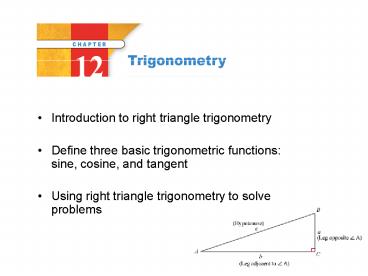Introduction to right triangle trigonometry - PowerPoint PPT Presentation
1 / 8
Title:
Introduction to right triangle trigonometry
Description:
Trigonometry is the study of the relationships between the sides and the ... If the angle of elevation from the sailboat to the top of the lighthouse is 16 ... – PowerPoint PPT presentation
Number of Views:1571
Avg rating:3.0/5.0
Title: Introduction to right triangle trigonometry
1
- Introduction to right triangle trigonometry
- Define three basic trigonometric functions sine,
cosine, and tangent - Using right triangle trigonometry to solve
problems
2
Trigonometry
- Trigonometry is the study of the relationships
between the sides and the angles of triangles - In any right triangle with the same angle
measure, the ratio of the lengths of the legs is
the same - This follows from AA similarity,
- since all such triangles are similar
- The legs are identified based on where
- they are in relation to the angle
- One leg is the side opposite the angle
- The other leg is the side adjacent to the angle
3
Trigonometry
- The tangent of an angle in a right triangle is
the ratio of the length of the opposite side to
the length of the adjacent side - If the length of one leg and the measure of one
angle of a right triangle is known, the tangent
provides a method of finding the length of the
other leg - Given the triangle at right, the tangent of 31
is 3/5 - Use the tangent to find the height of the tree in
this picture
4
Trigonometry
- In addition to the tangent, there are two other
trigonometric functions defined in this chapter - The sine of an angle in a right triangle is the
ratio of the length of the opposite side to the
length of the hypotenuse - The cosine of an angle in a right triangle is the
ratio of the length of the adjacent side to the
length of the hypotenuse - Trig functions are usually abbreviated tan, sin,
and cos - Scientific calculators usually have buttons for
these three trigonometric functions - Before calculators, the values were calculated by
hand, and books were published containing tables
giving the values of trig functions for different
angles
5
Trigonometry
- The mnemonic SOH-CAH-TOA is sometimes used to
remember the relationships between the sides
of a triangle and trig functions - Consider angle A in the triangle at right
- This is a function, not multiplication!
- This is read as sine of A, cosine of A,
tangent of A - Note that the leg opposite one angle is the leg
adjacent to the other angle
6
Trigonometry
- Trigonometry provides another way to use indirect
measurement with right triangles - Given a distance and an angle in a right
triangle, the length of any other side can be
found using sine, cosine, or tangent functions - Surveyors use trigonometry to calculate distances
in construction - Example
- Find the length of the hypotenuse of a right
triangle if an acute angle measures 20 and the
side opposite the angle measures 410 feet - First, make a sketch of the problem
- Determine which trig function to use
- SOH-CAH-TOA Sine Opposite/Hypotenuse
- Set up an equation and solve for x
7
Trigonometry
- If two sides of a right triangle are known,
inverse trig functions can be used to find the
angle measures - Scientific calculators can also find inverse trig
functions - The inverse functions are written as sin-1x,
cos-1x, and tan-1x - If sinA x, then A sin-1x
- For example, to find the angle with a sine of ½
- sinA ½ A sin-1(½) A 30
- Example
- Use an inverse trig function to find the angle
opposite the shorter leg of a right triangle with
legs of 8 and 15 inches - First, make a sketch of the problem
- Use inverse tangent to find mÐA
- tanA 8/15 A tan-1(8/15) A 28
8
Problem Solving with Right Triangles
- Two terms used when making observations using
angles - Angle of elevation is the angle looking up from
horizontal - Angle of depression is the angle looking down
below horizontal
- The angle of elevation for the person at left is
equal to the angle of depression for the person
at right - Example
- If the angle of elevation from the sailboat to
the top of the lighthouse is 16, and the
lighthouse is 121 feet tall, how far is the boat
from shore?































